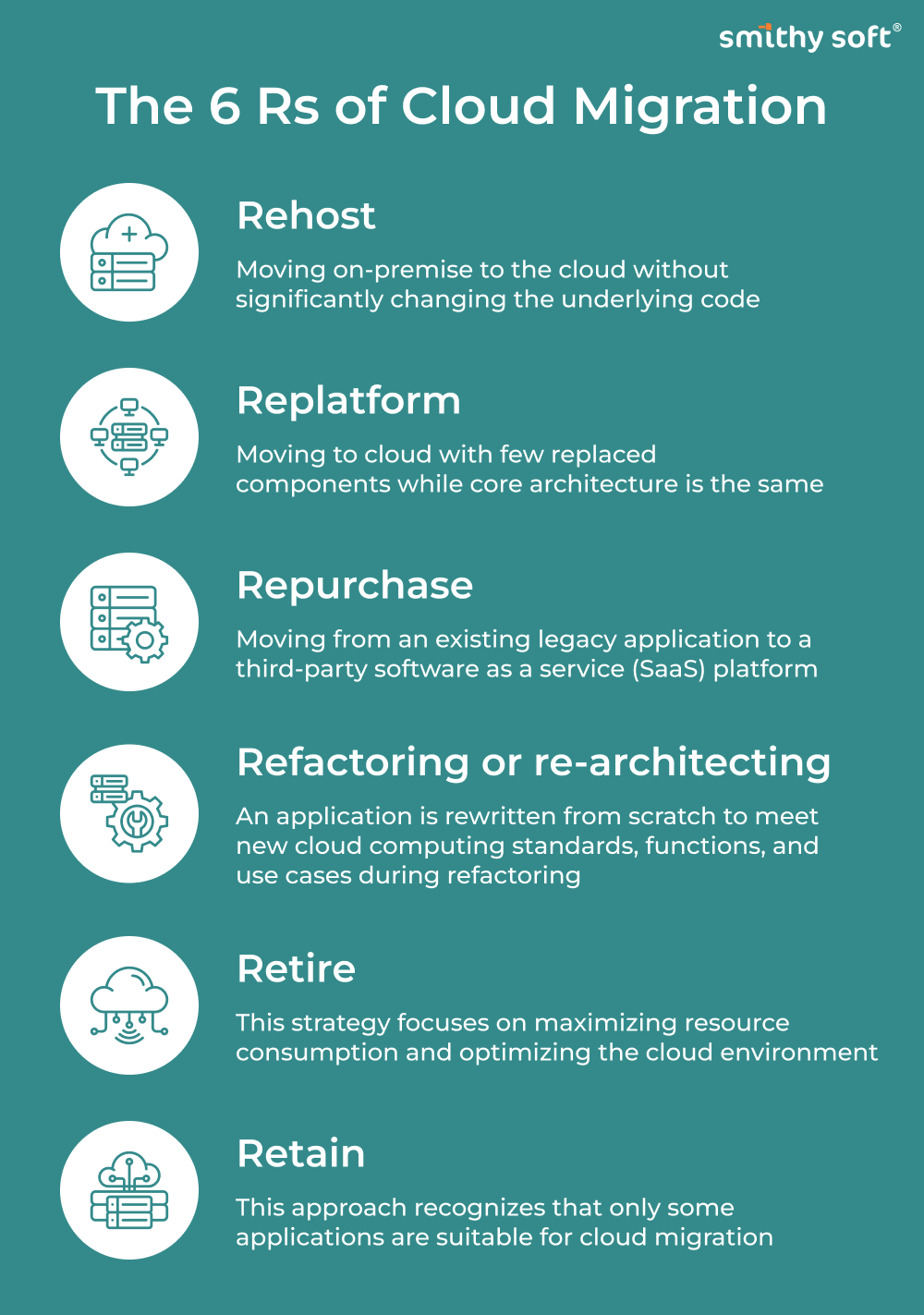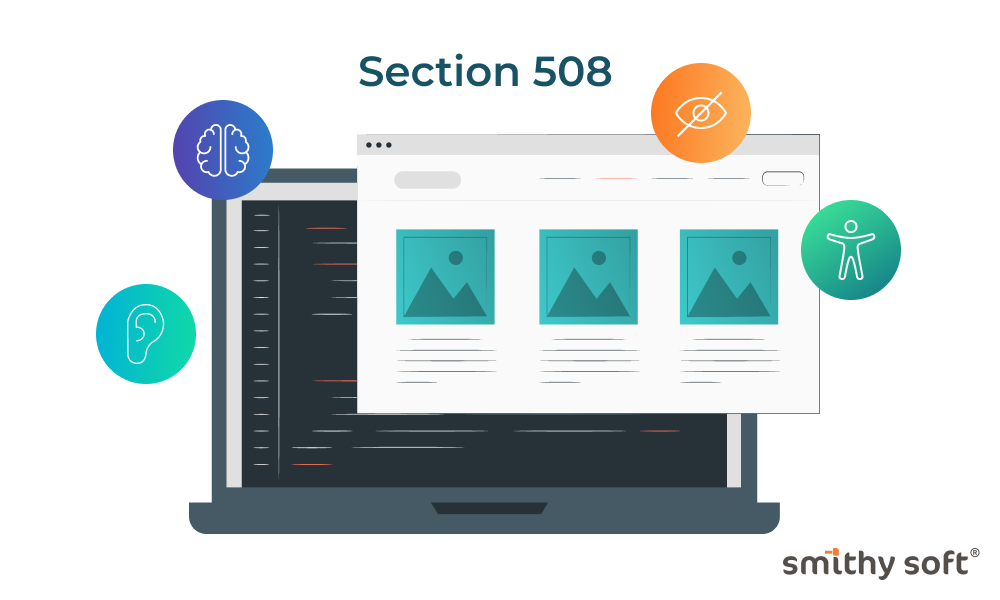Essential things about Cloud Migration: benefits, challenges, types, strategies, tools

At some point, all companies face the possibility or, more often, the necessity of cloud migration. This option is becoming a requirement of the times and is driven by a whole set of convincing advantages: scalability, flexibility, cost-effectiveness, security, etc. But moving to the cloud does not imply a one-size-fits-all solution. There are many nuances, opportunities, and features for different business needs. Let's take a closer look at these specifics.
What is Cloud Migration?
This is a partial or complete transfer of the company's digital assets, services, databases, IT resources, and programs to the cloud. Cloud migration also means moving from one cloud to another.
Cloud migration is critical to achieving updated performance and real-time efficiency. The cloud solution should be compatible with your business requirements. So it's crucial to understand that it's not just about getting to cloud migration but what you'll do once you get there.
Many questions need to be answered along the way, and companies of all sizes need help with their cloud journeys. SmithySoft is here to help you at every step of the way!
What are the benefits of cloud migration?
- Cloud-based applications and data can be accessed from anywhere via the Internet, which provides more opportunities for remote work and improved collaboration.
- Moving to the cloud makes it much easier for growing businesses to customize and add resources as needed. This includes everything from new SaaS tools from CSPs or third-party vendors to applications developed in-house.
- Lower operating costs: businesses with their assets deployed in the cloud do not need to set up and manage their data centers. This significantly reduces overhead costs typically allocated to hardware, licenses, IT staff for maintenance, etc.
- Cloud providers handle infrastructure upgrades and software patches, freeing up your IT team to focus on strategic initiatives.
- Cloud infrastructure is easily scalable to meet changing business needs. This negates the need to over-provision hardware to meet those infrequent peaks in demand and also allows organizations to quickly reduce cloud costs when resources are not in use.
- Cloud services are often designed to be delivered by end users without the need for in-house technical staff. For example, a developer who needs a test database can create an offline cloud database in minutes instead of waiting for a database administrator to find the time and hardware power to provide it.
- Cloud platform services offer the latest versions of databases that can offer features such as the ability to manage multiple types of data and provide machine learning within the database system, which greatly simplifies the architecture required to extract value from data.
- Cloud providers invest heavily in security measures and disaster recovery solutions, potentially offering better protection for your data than on-premises infrastructure.
Risks of cloud migration
Despite the long list of potential benefits we mentioned above, there are always certain risks, depending on the specifics of your business and the realities of your environment. Here are some of those risks:
- Distributed cloud architecture may not fit your application design or configuration. This may mean you might consider changing them before they can be moved to the cloud.
- For companies with hundreds or thousands of databases and applications, moving data and business processes to the cloud can be a complex task that requires careful identification, planning, and skillful execution. Often, such large-scale migrations are performed incrementally.
- For some very high-bandwidth applications (e.g., financial trading or telecommunications applications), the time it takes to send data over the Internet to the cloud provider, a period called latency, can be an issue that needs to be planned for and addressed.
- Some data cannot be moved to the cloud provider's data center due to the company’s policy or data residency rules.
- Vendor lock-in is a common problem for cloud users. Cloud providers offer many services, but some are unavailable on other platforms. Moving workloads from one cloud to another is a long and expensive process. Many organizations start using cloud services and later find it difficult to switch providers if the current provider does not meet their requirements.
- The migration process itself creates security risks. Transferring large amounts of data that may be confidential and setting up access controls for applications in different environments poses a significant risk.
Types of cloud migration
There are different types of cloud migration. They differ depending on what is being moved and where to:
- Full data center migration
This suggests moving all data, applications, and services from on-premises data centers to the cloud provider's servers. This process is typically extensive and requires careful planning and testing to ensure effective execution.
- Hybrid cloud migration
This involves moving some resources to the public cloud, while others remain in on-premises data centers. Companies also use hybrid cloud migration for data backup. In this case, the company backups its private cloud resources to the public cloud as a mitigation method when an attack or disaster renders the on-premises data center inoperable.
- Business processes migration
This is the simplest form of cloud migration, which involves moving only a limited set of web or mobile applications to a public cloud architecture to host and manage DevOps.
- Cloud-to-cloud migration
It can serve as a way to benefit from lower costs or to improve performance reliability, better security, and other factors.
Cloud Migration Strategies
A well-known framework for getting your cloud migration strategies sorted out is "The 6 Rs of Cloud Migration". This framework is not for every company, however, consider it an illustrative reference of the various routes for an organization to take.

1. Rehost
That involves moving on-premises data and applications to the cloud without significantly changing the underlying code. This is the easiest, most cost-effective, and least time-consuming way to migrate to the cloud. It is often called "Lift and Shift" because you basically lift your entire IT infrastructure and move it to the cloud provider's data center.
2. Replatform
This is where an application is moved to the cloud and its underlying infrastructure is rebuilt to utilize the functions built into the cloud. Replatforming involves changing the code of your applications to make them compatible with and run in the cloud. This approach is ideal for organizations that want to improve service delivery by modernizing legacy applications.
3. Repurchase
This involves moving applications and data to a ready-made cloud product. The process involves moving from an existing legacy application to a third-party software as a service (SaaS) platform. This makes sense if you want to take advantage of the new benefits of cloud computing without doing all the work of building and maintaining it yourself. It's also ideal for migrating applications and data that are difficult to re-host.
4. Refactoring or rearchitecting
An application is rewritten from scratch to meet new cloud computing standards, functions, and use cases during refactoring. Building an application from scratch can be time-consuming and expensive. However, it's also the most efficient and future-proof way to utilize the latest cloud computing benefits, including serverless computing and native-level automation.
5. Retire
This strategy focuses on maximizing resource consumption and optimizing the cloud environment. After a comprehensive study, applications identified as legacy are removed from the migration process. This can reduce effort and resource usage in the cloud environment by avoiding moving applications that are no longer needed.
6. Retain
This approach recognizes that only some applications are suitable for cloud migration. Applications may be maintained on-premises for many reasons, including technology dependencies requiring easier management in the cloud, security concerns, or compliance requirements. Keeping certain applications on-premises ensures that they continue to operate while addressing some of the challenges associated with cloud migration.
Migrating to the cloud: the sequence of actions
Step 1. Planning
Establish your business goals for cloud migration. These goals may include increased flexibility, cost savings, improved performance, or scalability. Perform an initial assessment of your IT infrastructure to understand what resources you have and how to better transfer them. Assess your cloud readiness by identifying any skills or technology gaps that might need to be addressed before migration happens. Next, create a business case for each application you plan to move to the cloud, showing the expected total cost of ownership (TCO) in the cloud versus your current TCO. Cloud migrations are a significant investment, so make them where the ROI makes sense now or shortly.
Step 2. Choose the best cloud environment for your needs
Evaluate the advantages and disadvantages of public, private, hybrid, and multi-cloud approaches; this way, you can choose whatever suits your needs best. This is also the time to address any compliance or security requirements associated with the migration.
Step 3. Migration
This is the actual process of moving data, applications, and other workloads to the cloud. The phase can include multiple options from the Cloud Migration Strategies listed above.
Start by installing a cloud firewall to prevent data leakage. Also, make a backup of your data in case you need to roll back changes in case of compatibility issues. Next, move your data to the cloud provider of your choice. You can upload your data to the cloud over the Internet. But if you have data-intensive applications, ask your cloud provider if they do on-site data transfers. Physical delivery of data to an on-premises data processing center can also be a faster and more secure approach.
Step 4. Evaluate your migration
After successfully moving workloads to the cloud, organizations move into the operational phase. This phase involves managing the workloads in the cloud environment, including performance monitoring, resource management, and maintaining security and compliance. During this phase, organizations should continue to improve their operations based on feedback and performance data, making the necessary adjustments to optimize cloud operations.
Step 5. Optimize
The last step in the cloud migration process is optimization. During this stage, organizations look for ways to improve the performance and efficiency of their cloud environment. This can include enhancing cloud operations, identifying cost-saving opportunities, and implementing cloud features or services to increase productivity. The optimization phase is an ongoing one, as companies are constantly looking for ways to improve their cloud operations and increase business value.
Cloud migration tools
DigitalOcean has compiled ten of the best cloud migration tools. These are specialized software solutions designed to facilitate the transfer of data, applications, and workloads from on-premises infrastructure to the cloud or between different cloud environments. These tools simplify the migration process by automating tasks, ensuring data integrity, maintaining security, and minimizing downtime.
- Azure Migrate is a service offered by Microsoft Azure designed to simplify and optimize the process of migrating various workloads to the Azure cloud platform. It provides assessment, migration, and optimization tools to help businesses efficiently move their on-premises infrastructure, applications, and data to Azure. The service meets a variety of migration needs, from small moves to large-scale enterprise migrations. It provides continuous assessment and tools to optimize resources after migration, ensure cost-effectiveness, and maintain performance efficiency.
- AWS Application Migration Service is created to optimize and reduce the cost of migrating and modernizing applications from various source infrastructures to AWS. The service allows organizations to move applications running in other public clouds to AWS, providing access to 200+ services that reduce costs and increase availability. It supports the migration of various applications, maintaining business operations throughout the application replication process.
- The Google Cloud Migration tools provide several services to help you migrate to Google Cloud efficiently. Google Cloud Migration Center acts as a unified platform for migrating from on-premises or other clouds to Google Cloud. Virtual Machine Migration specifically helps move physical servers and virtual machines, allowing virtual machines to run during the migration. Database Migration Service focuses on database transfers, and Transfer Appliance provides a hardware solution for large-scale data migration. In addition, the BigQuery Migration Service is designed to migrate from data warehouses to BigQuery. Each tool is designed for specific types of migration, providing end-to-end solutions in the Google Cloud ecosystem.
- AppDynamics offers a cloud migration solution designed to facilitate a smooth transition to the cloud. It is designed to help organizations assess, plan, and effectively execute their cloud migration strategies. Key features include baseline assessment (provides clear performance information for planning and prioritization), user experience monitoring, and post-migration validation (provides quick analysis to demonstrate migrations' technical and business success).
- Datadog is a comprehensive monitoring and security platform for cloud systems that provides deep visibility into cloud, on-premises, and hybrid environments during cloud migration. With Datadog, organizations can fully map their legacy and cloud systems and track real-time data at every stage of cloud migration. It offers specialized monitoring for a variety of cloud services, including Amazon Web Services, Azure, and Google Cloud Platform, providing a single source of truth and helping to plan, track, and resolve issues during cloud migration.
- Dynatrace is a platform developed to facilitate and improve the cloud migration process, from the initial planning stages to final performance optimization. Provides engineering teams with the information they need to understand their existing infrastructure and application layout, enabling more cost-effective and efficient migration. Leverages an integrated automation engine to automatically detect all microservices, enabling proactive detection and resolution of issues before they impact the customer.
- Flexera Flexera provides a complete suite of cloud migration solutions designed to help organizations efficiently move workloads to the cloud, assess cloud costs, and improve their cloud infrastructure. Its platform, Flexera One, provides critical insights and complete transparency into potential cost savings opportunities and potential risks, effectively guiding organizations through the entire cloud transformation journey.
- IBM Turbonomic is a cloud migration planning platform designed to accelerate and optimize digital transformation efforts. The tool performs in-depth, real-time analysis of the resource requirements of application workloads, developing customized application migration plans that outline strategic actions to support workloads and optimize costs. Whether an organization's strategy leans toward a single cloud, hybrid cloud, or multi-cloud approach, Turbonomic offers customized migration planning tools to improve the overall efficiency of the cloud migration process.
- Cloudsfer is a platform that facilitates the migration and backup of data between various cloud and on-premises systems. The service simplifies information transfer between diverse cloud environments or from a local system to the cloud.
- Carbonite Migrate provides a reliable and secure platform for transferring physical, virtual, or cloud workloads between the environments. It is designed with a focus on minimal downtime and low risk. It addresses common migration challenges such as potential data loss, IT resource allocation, outages, and interoperability barriers.
BOTTOM LINE
Cloud migration requires serious work and preparation. To avoid risks and make it successful, you need to develop your strategy and plan for cloud migration, determining what exactly and on what terms you will transfer in advance, and why – what KPIs you expect from this step. We advise you to use the services of IT consultants to help you make your cloud migration smooth, painless, and rewarding.


